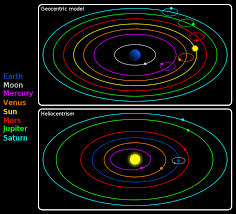The orbits of the planets were originally described as circular, but in the last few centuries they have shifted to more elliptical paths, indicating an ongoing adjustment to the cosmic changes.

The Milky Way, October 15 – It has been nearly five centuries since the universe’s shift from an Earth-centered solar system to one in which the planets orbit the sun, but the heavenly bodies are still acclimating.
For billions of years, the planets and stars were embedded in crystal spheres that circled the Earth. Ancient humans spent years tracking and describing the movements of the spheres, which would play music as they rotated through the cosmos.
Sometime after the year 1500, however, the heavens underwent a radical reorganization. For reasons still not entirely clear, from the sixteenth century onward it became more and more common to see descriptions of the planets, stars and other celestial bodies not as embedded in spheres that circled Earth, but as orbiting the sun.
Though the shift was gradual in human terms, on the cosmic scale the changes were all but instantaneous, generating trauma throughout the universe. No longer embedded safely in crystal spheres or inert ether, the planets and stars became eerily suspended in empty space, held intact and on course through gravity.
Gravity itself, previously an occult force, was transformed into a function of mass and distance, a change which Newton famously described. The debris created by the vast shifts also created an asteroid belt between Mars and Jupiter, and new planetary bodies come into existence – Uranus in 1781, Neptune in 1846 and Pluto in 1930.
But even those changes were hardly smooth. When Galileo observed what later became the planet Neptune in 1612 and 1613, he called it a star, indicating that not only have celestial bodies’ positions changed, their very composition has undergone a radical shift. A similar phenomenon was observed in more recent years when Pluto, which came into existence as a planet in 1930, transformed into a “Plutoid” in 2006. Astronomers are uncertain as to what changed in Pluto’s nature during that time, but it is possible that as a young, more recent arrival to the solar system, its composition and mass may be less static than other, more venerable celestial figures. Moreover, the orbits of the planets themselves were originally described as circular, but in the last few centuries they have shifted to more elliptical paths, indicating an ongoing adjustment to the cosmic changes.
The changes in outer space have not been restricted to our neighborhood. New planets have sprouted around distant stars – first, very massive, Jupiter-sized planets, and then smaller bodies closer to the size of Earth. The leading theory explaining the sudden appearance of so many exoplanets, as they are called, states that the spheres in which the stars and planets had been embedded had to be shattered for the grand restructuring to take place, and the fragments of the spheres coalesced into discrete bodies – first the loose, larger exoplanets, followed by the more compact, solid ones.
When the Hubble telescope found countless new galaxies in distant space less than a decade ago, astronomers were abuzz: never before had they seen spontaneous creation on such a massive scale. The Prime Mover, whose previous function was to rotate the spheres and control the movements of the heavenly bodies, had returned to a long-neglected activity: creation ex nihilo.
But changes in composition, size and orbit are not the only shifts that took place in the cosmos: the stars, though they seem not to have changed visibly, have lost their utility as predictors of the future. Whereas the constellations through which the sun appears to move once held sway over the destinies of individuals and societies on Earth, astronomers have not observed that phenomenon in recent decades. No new role seems to have been assigned to the stars, but with the galactic reorganization still apparently in progress, astronomers are loath to draw conclusions about any permanent state of affairs – the Static Model is apparently no longer accurate.
Astronomers plan to study these shifts further in the coming decades, including a meta-analysis of whether the changes bear a strong correlation with tectonic shifts in other sciences such as medicine, in which, for example, treatment by bloodletting and leeches no longer produces the desired outcomes.




